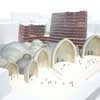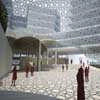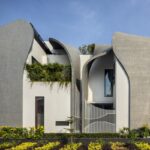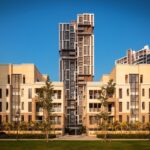Haj House Complex, Lucknow Building, Images, Architect, Design, Plans
Haj House Complex Lucknow : Indian Architecture
Contemporary Lucknow Building Proposal in India – design by AGi Architects
9 Aug 2010
Haj House Complex Lucknow
Architects: AGi Architects SL, Madrid, Spain
Haj House Complex
MEMO
“The first being created by God was light”. (…). The great masterpieces of Islamic architecture, such as the Alhambra, the Iwans and the courtyards of so many Persian mosques and the Taj Mahal, are like crystallisations of light, limpid and lucid, illuminating an illuminated, where the space of Islamic architecture is defined by light.
Hossein Nassr: Islamic Art and Spirituality. New York, 1981. pp 50, 51
Light, shadows, shelter, pilgrims, garden, paradise… the concept of the Haj House Complex in Lucknow is hereby, through this proposal, addressed as a cord connectively fastening the stems of some of the main features in Islamic traditional architecture; by trying to be much more than just the sum of different functional requirements housed within “rational” buildings, we wanted to push stronger and farther, in order for those concepts to be tangible in the final scenario. The character of the Haj itself as an iconic perception for Islam is present through these different features in the building that face the city across the river.
Thus we utilized components such as the shadows to shelter people approaching the complex, and envisioned the iwans in Persian architecture. We also conceived of the garden over which the Taj Mahal stands and brought it inside. We visualized the effect of the light filtering through the holes in the domes of the mosques and bazaars, and realized it for our building covering the main lobby plaza. We wanted to experience the contrast between the deep and heavy shadows of the iwans outside and the bright daylight that penetrates down and through the domes, as it happens in the Taj Mahal, so that the façade containing the iwans marks a contrast with the universe behind it; we featured towers for administration and accommodation uses and we concluded the domes for common public uses.
In the end, we wanted a building that could not only cater to any user involved in the process of training and educating relating to Haj, but that could also be open and accessible to the general public as an educational facility conveying the spirit of Islam; it is an abode for the pilgrim, a support for all the rest of the cultural and leisure amenities, and an educational harbor welcoming anyone interested in the teachings of Islam. All in all, a building is drawn and imagined composed of colors from the palette well endowed with the emanating features of Islamic culture.
IWANS
As a motif of Islamic Culture in a city where Muslims are a minority, the Complex’s architecture has to be taken into thoughtful contemplation due to the controversial nature of the building in relation to the city. Those notions are integrated in the site located on the Gomti River margins, creating an edge that casts a reflection of the city onto itself. The site’s hem embodies a set of modified prevalent Iwans of various sizes; the scattering of these arches offers a landmark urban plaza to the water front, which merge into the Persian domes of the Lobby Plaza; these Iwans not only symbolize Islamic and Persian architecture bridging history with modernity, they are also used as a universal gateway structure, projecting inviting volumes, opening the visage to engage all. Although open-faced, the vaulted anatomy of the Iwans and their concavity inwards introduces a secondary transitional threshold, where one is captivated, shadowed and sheltered by its walls before entering into the integral body of the site.
LOBBY
The dual nature of the interiority and opening of the lobby not only constitutes a juncture in between the three components of the Haj House Complex, but also provides for a smooth transition from open-air exterior platform to outdoor interior lobby. The interior lobby is extended outwards providing a link to the outside; baring a vast Urban Platform that is graded leaving an impression on the street, distinguishing the space for crowds to convene placidly for concerts and religious and public events, and raising the entrance for protection during monsoon season. By embarking on this simply elevated ground one becomes immediately engaged with the journey into the Complex subsequently bringing Haj closer.
The Plaza is raised +2.00 to receive dominant winds and cross ventilation from the river, its funnel shape creates wind circulation under the cupolas to cool both the towers double façade and the domed roof of the convention center. Once entering through the gates one is encompassed by clustered domes that subdivide the open space, slowing down the busy pace of the street and decreasing the scale for a more intimate encounter.
The visitors and users filter through the threaded Lobby to their desired section, the circulation is divided into three independent locations and levels; the Convention Center to the left use the same ground as the lobby and therefore speaks with a similar dialogue adopting programs that could be shared by the multiple users; the floor is split further centrally into higher levels +4.00 which is used for entrance into the Islamic Center, therefore those on their path to Haj are once more set forward to be transformed; the LDA offices are to the right and the cafeteria inside the building opens up and flows into the Lobby. All three buildings can be directly accessed from the unified Lobby Plaza and separately accessed from the street ground level +0.00.
DOMES
The Persian domes are used as a sun protecting device, and strongly symbolize Islamic architecture through their representation of the vaulted heaven and sky. The plaza therefore is seen as an extension of the mosque, guiding visitors closer to their journey.
Haj House Complex – Building Information
Location: Lucknow, India
Client: Private
Type: Islamic Center Haj
Size: 34,500 sqm
Status: Competition
Date: 2010
Category: Future Projects – Competition entries
WAF Entry: 2010
Award: World Architecture Festival 2010 – Shortlisted
Haj House Complex Lucknow India images / information from FD
Location: Lucknow, India
Architecture in India
Indian Architecture Designs – chronological list
New Delhi Architecture Walking Tours by e-architect
Indian Architect : architecture practice contact details
Vidyalankar Institute of Technology Mumbai
Design: Morphogenesis
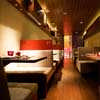
image from architect
New Delhi Restaurant
Comments / photos for the Haj House Complex Lucknow page welcome
Website: Lucknow

